Hole in the Clouds
Sep 5, 2009
Avram Dimitrscu's father was a musician in a Romanian concert band, behind the Iron Curtain. In the 1970s, the band toured western Europe, including the Channel Islands, where Avram's mother, a native of Belfast, Northern Island, was working at a resort hotel. They fell in love, and when it came time for the band to return to Romania, she helped him hide and eventually defect.. Avram was born on the Isle of Jersey and raised in Belfast. His parents ran a catering business until the 1990s, when travel to Romania became possible. Then they bought a truck and began operating a charity, collecting donations of food, clothing, and everything else, and driving all the way across Europe every month or so to deliver the contributions to Romanians in need.
Avram grew up during the troubles in Northern Ireland, in a Catholic part of town, and enrolled as an art student at the University of Belfast. He worked at a McDonald's near campus during the school year but spent his summers abroad, in Maine, where he worked as a camp counselor at a boys' camp. It was there that he met fellow-counselor John Stein. Avram and John traveled together, and Avram spent time in Alabama with all the Steins--always with his sketchbook in hand. Eventually, he married an American woman and moved to the town of Alpine, in the Big Bend area of extreme west Texas. He paints, illustrates, teaches art, runs the Dimitrescu Gallery, and surely still keeps his sketchbook close at hand.
This is his "Tiny Chicken #8."

Texas
Romania
painting
Northern Ireland
chicken
animal
John Stein
Avram Dimitrescu
(Image credit: Avram Dimitrescu
Sep 4, 2009
Joe Stein is admiring dinner. It should be tasty, thanks to Joe's buddy Joe Fair, who went catfishing the other night in the Black Warrior River near Moundville, Alabama.. According to one of the Joes, it took an hour to reel in the big guy.
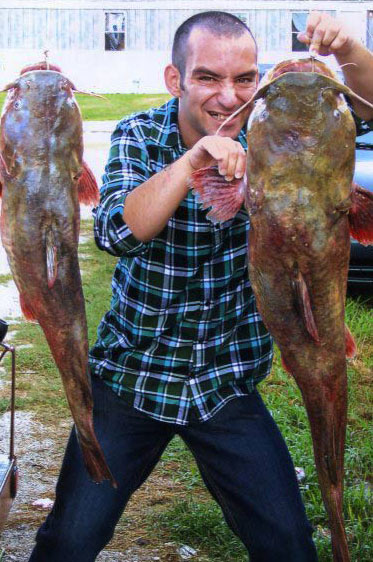
Alabama
animal
food
fish
Joe Stein
Joe Fair
(Image credit: Joe Fair)
Sep 9, 2009
Yesterday, Tanja Baker noticed this arachnid, named her Thekla, watched her eat three bugs, and got her to pose for a picture.
Thekla is about an inch long from toe to toe. "Too bad I have to work," Tanja says, "and cannot watch this all day." Thekla's name is from the spider in a German children's story, "Maya the Bee."
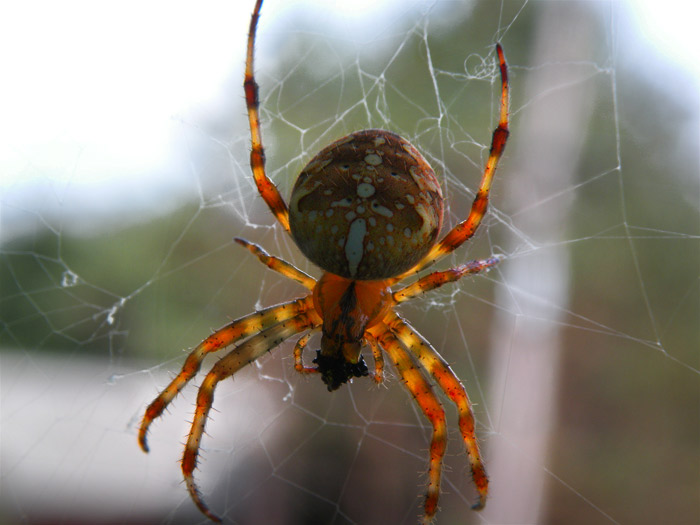
animal
spider
Tanja Baker
(Image credit: Tanja Baker)
Aug 29, 2009
On a couch or a soft carpet, Dobby the dog is pretty good about sitting on command. But on a hard floor? He'll make a show of pretending, as shown here with Emily and Joshua Wiggin, who are very good at kneeling.
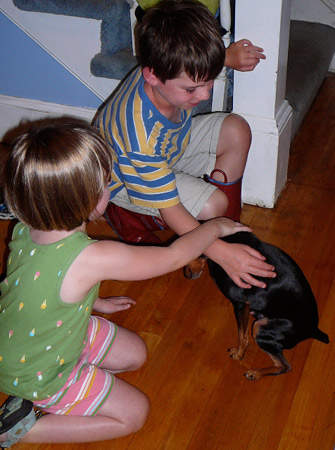
animal
Portland
Maine
dog
Dobby
Joshua Wiggin
Emily Wiggin
(Image credit: Ellen Stein)
Sep 15, 2009
It's springtime in New Zealand, time for the Stein sheep to get themselves sheared. Here, Moe is already nekkid, while Curly waits her turn. A., the family shepherdess, says she is "contemplating" learning to spin the wool.
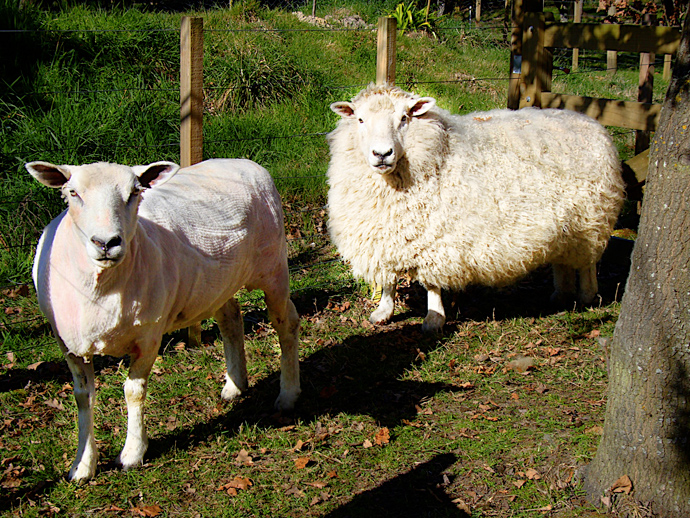
animal
sheep
New Zealand
A.
(Image credit: A. at kiwi-stories)
Aug 22, 2009
Time to catch up with the Mongol Rally folks. After about six weeks on the road now, many of the 200 or so teams have recently reached Ulaan Bataar, where they signed the rally book, did their laundry, and partied. There is no prize for arriving first. Rallyers donate their vehicles to Mongolian NGO's and eventually make their way home somehow.
A team called Rolling Cones, from Richmond, Virginia, spent three days wandering in the Gobi Desert in their pink ice cream truck. They say the rocks in the Gobi are so iron-rich that compasses don't work there. Mongol Rally rules discourage GPS navigation, but the Rolling Cones had secretly stashed a little GPS unit deep in their luggage for just such a contingency--not that they anticipated exactly such a contingency, but contingencies happen. They noticed that a roadwork crew was speaking Mandarin Chinese instead of Mongolian, and it had been three days since they'd last known where they were, so . . . turned out they were in the extreme southeast corner of Mongolia, a few kilometers from the Chinese border, in a spot on the map that was completely empty of roads. But there was a coal mine nearby, which is why the Chinese were building a new road, and at the mine there were two geologists from Virginia Tech. So it goes.
All the blog posts are full of promises to post their Mongolia photos soon. I trust them, of course, so I'll make the same promise. In the meantime, here's a nice one from back in Kazakhstan, near the shriveled shore of the Aral Sea. Photo by Team Mongoliza, who list their hometown as "southeast Asia."

animal
Mongol Rally
Kazakhstan
Gobi Desert
camel
Aral Sea
(Image credit: Team Mongoliza)
Aug 21, 2009
Ever since last week, the Susquehanna River's been missing a big fish. Just kidding--he threw it back. Allen says this small-mouth bass is 19 inches long and weighs about four and a half pounds.
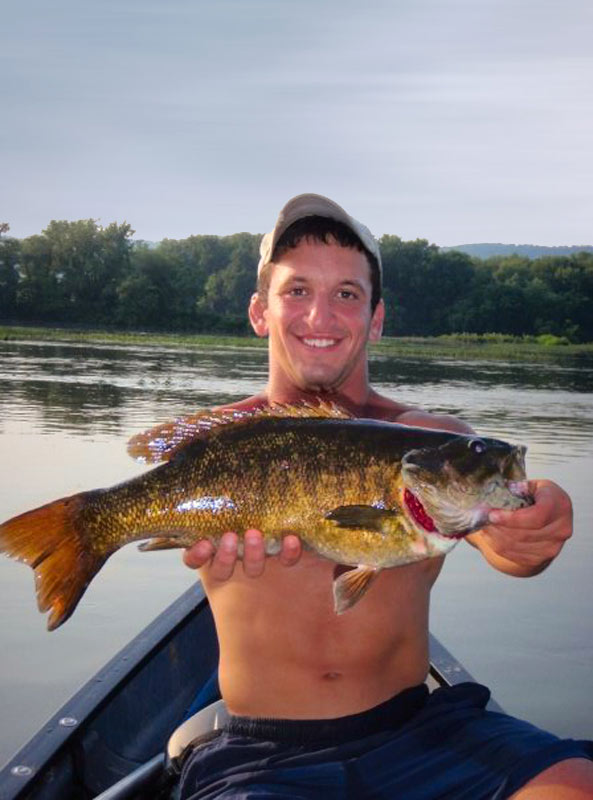
animal
fish
Allen Stein
Susquehanna River
Pennsylvania
(Image credit: Mike Landis)
Aug 18, 2009
Family life among the animals can get up close and personal with a webcam aimed 24/7 at a mud wallow in the forest claimed by a pack of wild boars, or a nest of sticks atop a telephone pole where a couple of storks have laid their eggs. But that was last summer and the summer before--this year, in Estonia, the webcams are mounted at an ostrich farm. One clutch of baby ostriches has hatched now, and you can watch the fluffy little bird-brained things squirming and snuggling under a heat lamp. Mom and Dad are outside in a paddock, incubating another nestful of eggs--looks like the male and female take turns sitting on the nest.
Go here to get your fill of ostrich video eye candy. The website is in Estonian, but even we Amurricans can figure out how to click on the pictures.
Hey, it's free--watch those ostriches all you want. The heatlamp is left on round the clock, so time zones won't keep you and those babies apart. Outside in the paddock, it gets light in Estonia around 10 or 11 p.m. Eastern daylight time. If you're up late, you can turn on the ostriches and watch them sitting on the nest and bobbing their heads a little, strolling along the fence line, grazing in the grass. Will you get bored? Yes--you're not an ostrich. But technology can hold your interest: instead of watching the ostriches in real time, you can click on another date and hour, and see what they were up to back then. By dragging your mouse across the bottom of the video frame, you can watch everything the ostriches did that hour in just a few seconds, and you can even watch them in reverse. Clouds will race across the sky, the sun will leap up from the horizon, and the ostriches will hop about right smartly.
If you could speed up the entire first year of video of a baby ostrich's life, you'd see it gain 100 pounds and grow as tall as an adult human. By age 3 or 4, mature ostriches can be 9 feet tall and weigh 350 pounds. They have three stomachs but no gall bladder, in case you were wondering.
There would be little point in speeding up video of an ostrich running; they can go from 0 to 27 miles per hour in a couple of seconds. Sometimes people race ostriches, with jockeys on their backs using saddles and bridles. They are said to be much more difficult to control than horses, but also much faster.
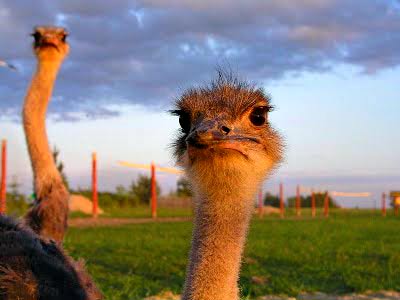
animal
ostrich
Estonia
(Image credit: unknown)
Aug 17, 2009
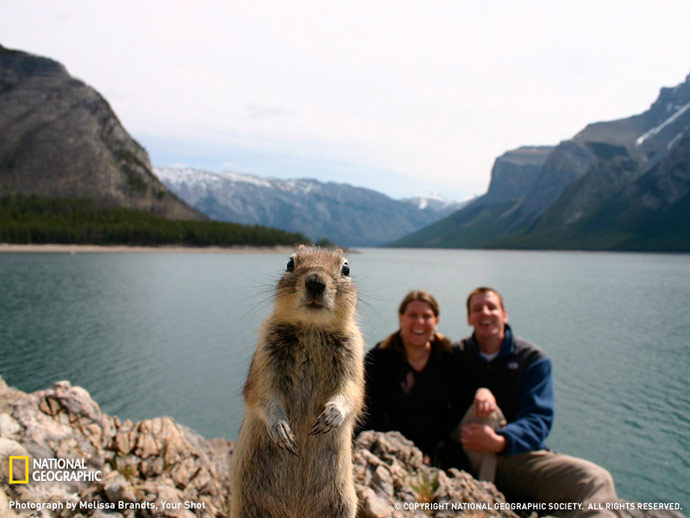
They wanted a picture of themselves at their lakeside campsite in Banff National Park, so they put the camera on a rock and set the shutter for a delayed snapshot.
The whirring sound made by the camera as it prepared to snap attracted a squirrel, who chattered right back at it and got himself nicely pixellated for his 1/250th of a second of fame.
Or so it said on the National Geographic website. Hat tip to John "J.J." Stein for this fine submission to our irregular summer series of cute animal pictures. (Yes, there are more....)
animal
John Stein
Canada
squirrel
Banff National Park
(Image credit: National Geograpic)
Aug 16, 2009
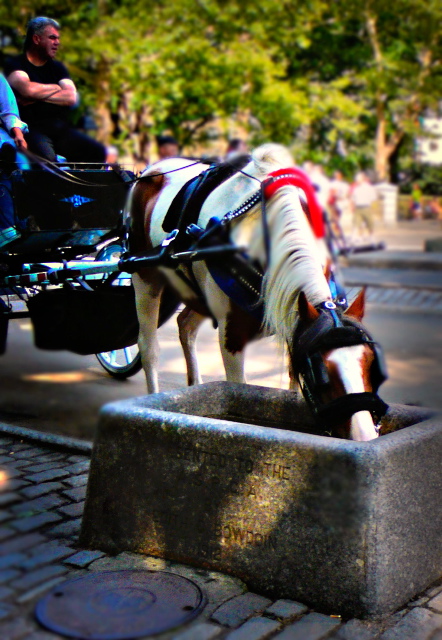
Even in the leafy dapple of New York's Central Park, these are dog days for horses.. The inscription on the trough reads: "Presented to the S.P.C.A. by Edith D. Bowdoin, 1912."
New York
animal
Central Park
Edith D. Bowdoin
horse
(Image credit: Ellen Stein)
Aug 14, 2009
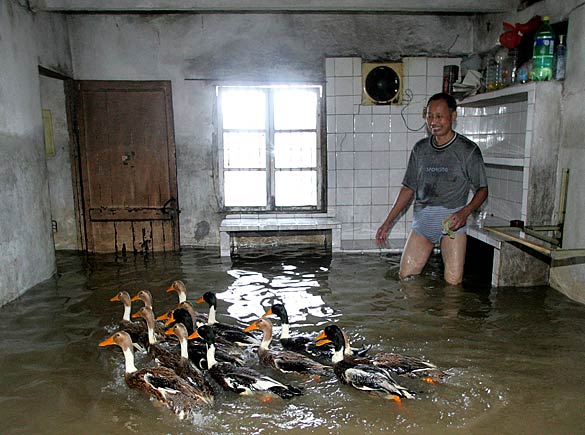
Last weekend, Taiwan was hit hard by Typhoon Morakot.
animal
duck
Taiwan
Aug 10, 2009

animal
dog
Manno
Stella
(Image credit: Ellen Stein)
Oct 4, 2009

Several of you asked to see more work by our Romanian Northern Irish West Texas friend Avram Dimitrescu. He calls this acrylic painting "Longhorn and Mountains."
For many more images, see Avram's blog and his portfolio website. He doesn't just paint chickens and cows, though I might be satisfied if he did; he's also got paintings and drawings of landscapes, buildings, vehicles, food, and the digging arm of an excavating machine.
Texas
painting
animal
Avram Dimitrescu
cow
(Image credit: Avram Dimitrescu)
Oct 17, 2009

There's an urban legend about a deer more spectacular than any other, a deer that's pure white, maybe even albino. It is glimpsed from time to time, usually at dusk or dawn or even after dark. It's shy and quick, won't stick around for the camera.
For a hunter to shoot such a deer, a white ghost of a deer, would make the whole forest cry. It would bring a whole lifetime of bad luck to the hunter who felled it. Unless it was actually a good luck charm. Or a trophy like no other--a trophy deer above all others.
One problem with the white deer, urban-legend-wise, is that there's widespread disagreement concerning what it might signify, if it signifies anything. The story is messy, if there is a story to it. But that's okay, urban-legend-wise, because the white deer is real--an estimated 1 deer out of 30,000 is albino, completely white with pink eyes.
Their coloration leaves them especially vulnerable to human hunters and other predators. Do they know that? Is that why they are so shy? Perhaps not, but their light-sensitive eyes may make them avoid daylight even more than other deer.
Nonetheless, Janet Goldwater sort of got a photo of an albino deer that had been eating apples from her tree in Eagles Mere, Pennsylvania. "This photo was taken (in a rush obviously!) through the window of my house," she writes. "My opportunity to take a photo came at dusk, hence the slow shutter speed."
Here, the albino deer looks almost like a unicorn, which seems appropriate enough. If you want clearer pictures, you can find them on the tubes. But this shot seems to pretty much sum up the whole white-deer thing: whatever is out there is hard to see, impossible to pin down, fleeing fast , but definitely, positively, really something.
animal
Pennsylvania
night
deer
(Image credit: Janet Goldwater)
Oct 25, 2009

"The Storybook Wolf," by Spanish photographer Josi Luis Rodriguez, won National Geographic's 2009 prize for wildlife photography. To get the shot, Rodriguez rigged up a motion sensor that tripped the shutter of his camera, which used an infrared sensor for night vision.
I know this wolf. He eats grandmothers and little pigs and little Russian boys, and I'm sure he's very hungry now.
animal
Spain
night
wolf
National Geographic
(Image credit: Josi Luis Rodriguez)
Nov 24, 2009
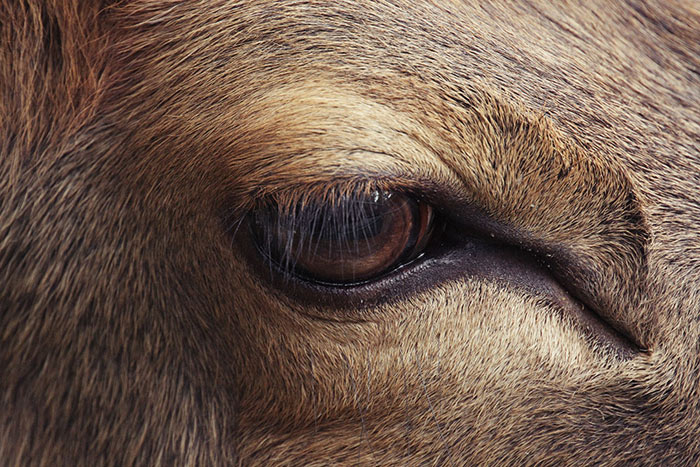
Wait. I mean . . . wapiti.
animal
wapiti
(Image credit: Oscar)
Dec 18, 2009

This is an ibex, photographed by Ruggero Barsacchi on safari in . . . Italy.
I guess I didn't know my ibex from my keister. To me, this guy looks like African big game, maybe an antelope sort of creature that might even give a lion a hard time. Nope. You're looking at lo stambecco, the mountain goat of the Italian Alps.
Ibexes are not really big enough to take on lions, but at 100 kilograms or more, with horns up to a meter in length, a full-grown male ibex can do a number on a wolf. Prized medicinally--almost all its body parts and also its excrement were said to cure whatever ails you--by the early nineteenth century it had been hunted almost to extinction. Ibex herds are now protected and have grown dramatically; the species is no longer considered particularly endangered.
animal
landscape
Alps
ibex
(Image credit: Ruggero Bersacchi)
Dec 19, 2009
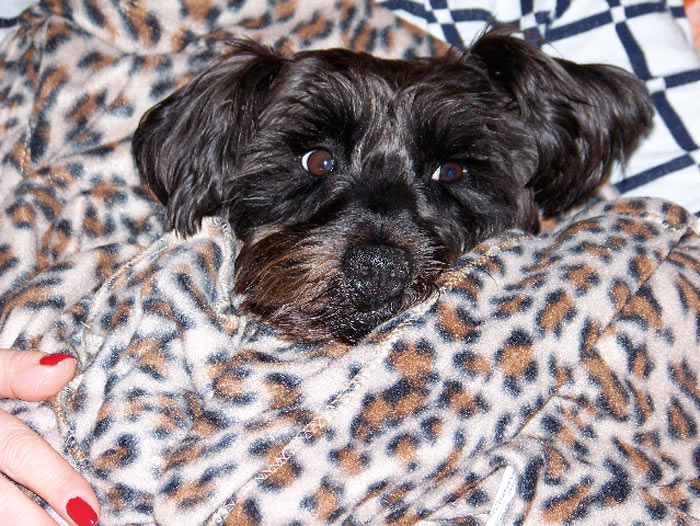
Some people think it's been way too long since the last cute puppy picture, so . . . here's Stella, looking up at us from Michele Manno's lap. Clearly, the leopard-print fabric doesn't fool her for a minute.
Michele Manno
animal
dog
May 18, 2010

A bee pollinates a lotus water lily in the Orchid Garden in Kuala Lumpur, Malaysia.
animal
flower
Kuala Lumpur
Malaysia
bee
Jul 28, 2010

Even so, we should maybe check the locks.
This is somebody's side door near Rittenhouse Square in Philadelphia.
animal
streetscape
Philadelphia
(Image credit: Ellen Stein)
Jan 15, 2011
 Believe it or not, there are in this world orangutans who just don't know what orangutans need to know. There are also orangutans who know full well how to be orangutans but who because of injury or illness can't get with the program. There are also orangutans who know how to be orangutans and are able and willing to live the orangutan life but who've lost their habitat.
Believe it or not, there are in this world orangutans who just don't know what orangutans need to know. There are also orangutans who know full well how to be orangutans but who because of injury or illness can't get with the program. There are also orangutans who know how to be orangutans and are able and willing to live the orangutan life but who've lost their habitat.
On their own in the wild, these unfortunate orangutans are not going to make it. But if they are somehow directed to the Sepilok Orangutan Rehabilitation Center just outside of Sandakan, on the north coast of Borneo, even they can live happily ever after.
Sepilok is basically a feeding station with no walls; orangutans can eat there forever, come and go at will, or hang around for a while and then give life in the jungle a try. There's also a nursery for orphaned babies, who grow up unafraid of humans or orangutans; by growing up in orangutan paradise in the company of numerous adult orangutans, the orphans have a good shot at learning all the good stuff about orangutan ways.
This fellow certainly looks like proof of concept.
animal
Borneo
Sepilok Orangutan Rehabilitation Center
Sandakan
(Image credit: A. at kiwi-stories)
Feb 27, 2011
 Dobby the dog says: Why wait for spring?
Dobby the dog says: Why wait for spring?
animal
dog
Dobby
Jul 7, 2011
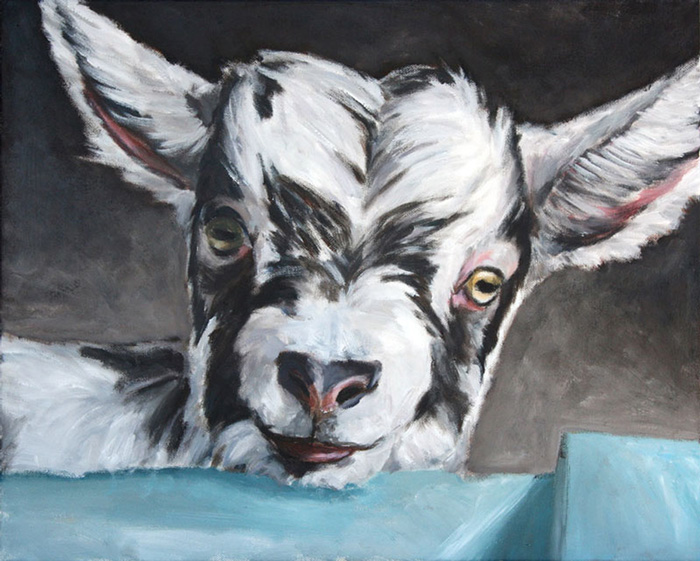 Baby Goat, by Avram Dumitrescu, our very own Romanian Irish Texan painter. Click through for Avram's story and some more of his paintings.
Baby Goat, by Avram Dumitrescu, our very own Romanian Irish Texan painter. Click through for Avram's story and some more of his paintings.
painting
animal
art
baby animals
Avram Dumitrescu
goat
Dec 3, 2011
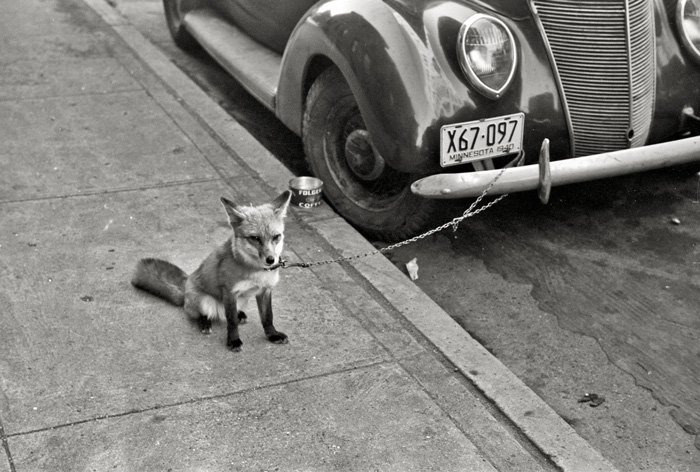 Maybe the gingerbread man was in that Folger's coffee can?
Maybe the gingerbread man was in that Folger's coffee can?
Government photographer John Vachon immortalized this scene while he was doing his Farm Security Administration work in Minnesota and the Dakotas in the spring of 1940. But he didn't record any explanations.
animal
car
Minnesota
1940
fox
Moorhead
(Image credit: John Vacon, Farm Security Administration, via Shorpy)
Dec 7, 2011
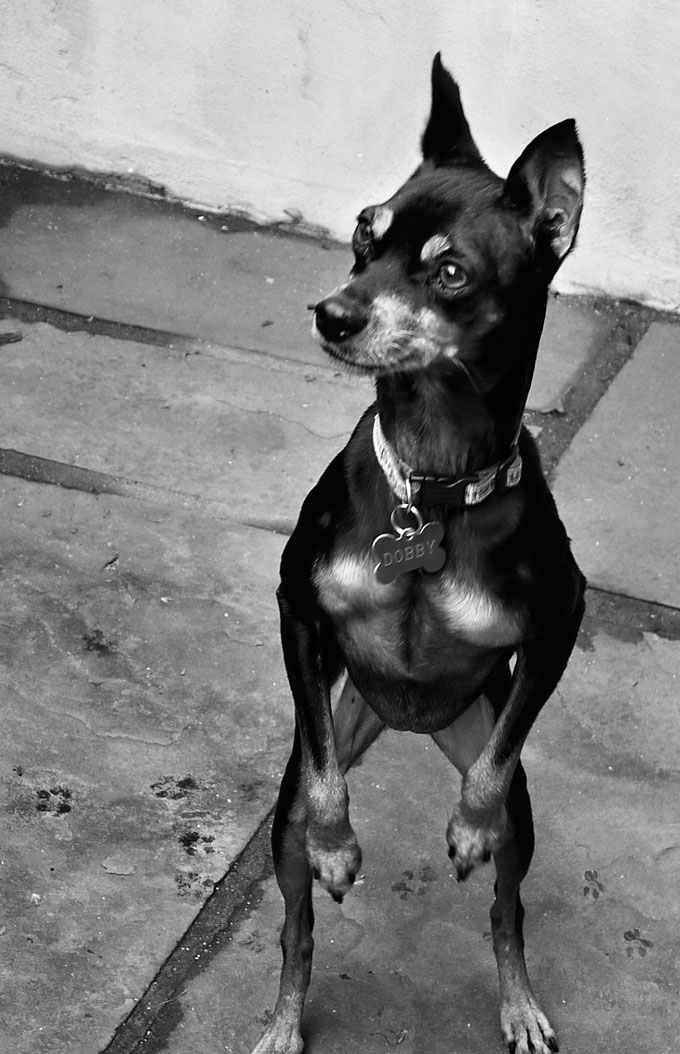
It's been a while since we've served up puppies or babies in this space, so here's the Dobster, hopping about on two wet feet.
animal
dog
Dobby
cute
backyard
Dec 21, 2011
 This species of duck is native to Africa and is ubiquitous throughout the continent, except in deserts and deep forest. It is not native but nonetheless ubiquitous in many parts of Europe, especially England, where it was introduced more than three centuries ago and has thrived in town and countryside to such an extent that it was added last year to the official national list of animal pests. This picture was taken recently in London.
This species of duck is native to Africa and is ubiquitous throughout the continent, except in deserts and deep forest. It is not native but nonetheless ubiquitous in many parts of Europe, especially England, where it was introduced more than three centuries ago and has thrived in town and countryside to such an extent that it was added last year to the official national list of animal pests. This picture was taken recently in London.
The birds are known as Egyptian Geese, despite the fact that they are ducks, not geese. Apparently, they have a heavy-looking habit of flight that makes them look goose-like in the air.
animal
duck
London
Africa
bird
goose
Mar 9, 2012
 Another visit with the chained beast of Manning Street, at the side door of a dress shop near Rittenhouse Square.
Another visit with the chained beast of Manning Street, at the side door of a dress shop near Rittenhouse Square.
animal
streetscape
Philadelphia
Rittenhouse Square
scullpture
Manning Street
doorway
storefront
(Image credit: K. Maldre)
Nov 17, 2012
Fair Oaks District, Centreville Rd., 2300 block, Dec. 7. Animal control was called about a squirrel running inside a residence. When an animal control officer saw the squirrel, it jumped into an open baby grand piano. After the officer started playing the song "All I Want" by the group Toad the Wet Sprocket, the squirrel jumped out of the piano and onto curtains, damaging them. The squirrel then jumped onto the officer's head and pounced onto a couch, where the officer was able to catch it. The officer released the animal outside. Neither the squirrel nor the officer was injured.
(Reprinted from the February 12, 2001, edition of New Yorker magazine.)
animal
piano
music
squirrel
Constabulary Notes From All Over
May 27, 2013
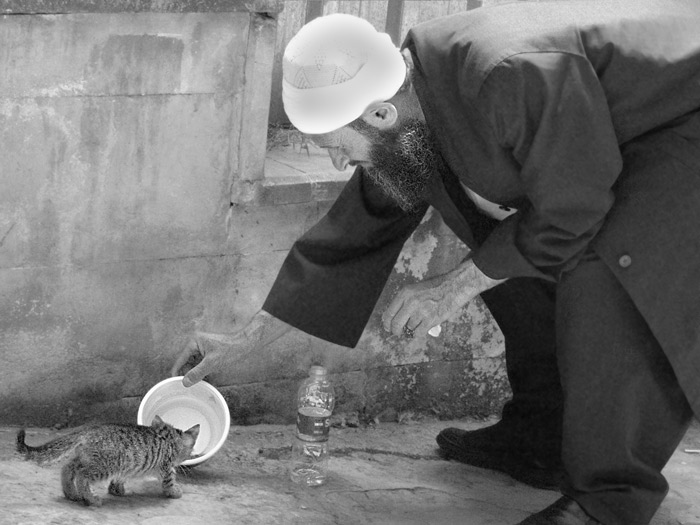 From friends and neighbors in Turkey comes this Istanbul street scene.
From friends and neighbors in Turkey comes this Istanbul street scene.
animal
Turkey
cat
baby animals
Istanbul
(Image credit: Frank Schlupp)
Sep 30, 2013
 Paganini the little poodle sits up in bed.
Paganini the little poodle sits up in bed.
animal
dog
Paganini
pet
poodle
bedroom
(Image credit: Little Fuji)
Oct 29, 2013
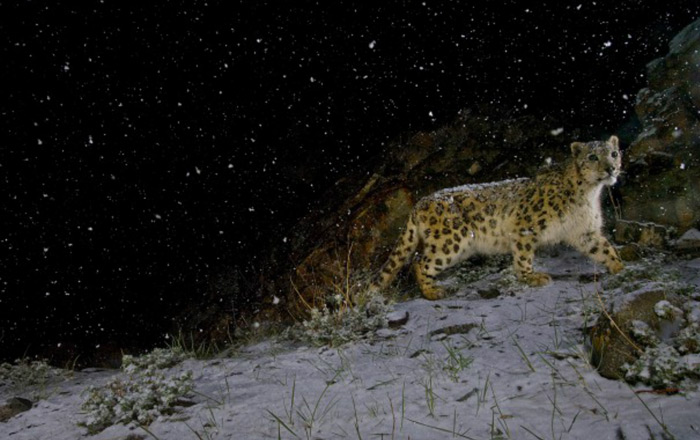 In Hemis National Park in the extreme north of India, near the Tibetan border.
In Hemis National Park in the extreme north of India, near the Tibetan border.
animal
mountains
night
India
Kashmir
(Image credit: National Geographic)
Jan 26, 2014
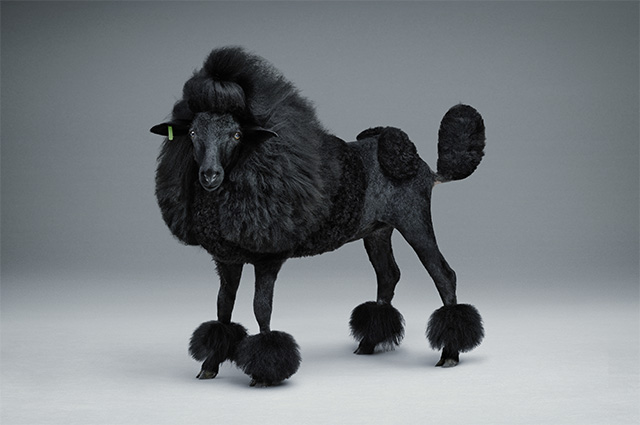 This is not, of course, a New Zealand sheep; it's a Dutch sheep, trimmed to look not so much like a sheep, at the behest of Amsterdam artists Lernert & Sander, who'd been hired by a newspaper to illustrate a series on the theme of family.
This is not, of course, a New Zealand sheep; it's a Dutch sheep, trimmed to look not so much like a sheep, at the behest of Amsterdam artists Lernert & Sander, who'd been hired by a newspaper to illustrate a series on the theme of family.
Human families, needless to say, have black sheep. What about black sheep families? It took dog groomer Marieke Hollander almost a full day to do up this sheep like a French poodle, but the result was, at least arguably, quite a black sheep among black sheep.
animal
sheep
Holland
Marieke Hollander
grooming
poodle?
DeVolkskrant
(Image credit: Lernert & Sander)
Mar 22, 2014
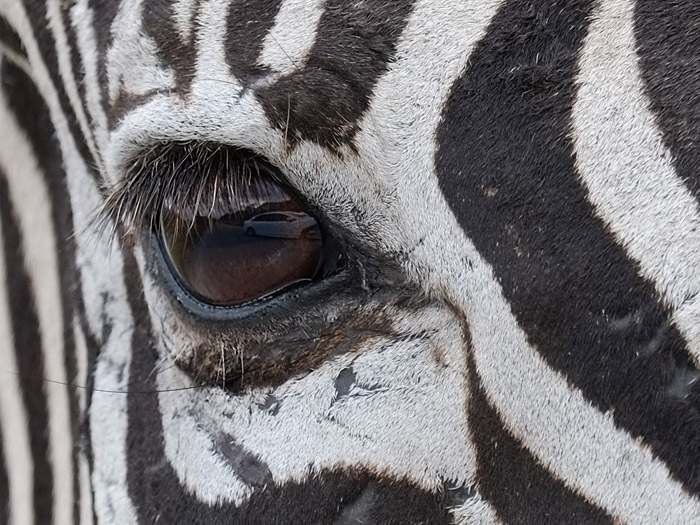 When the photographer snagged this zebra, he was shooting from the open window of the car that had caught the zebra's eye.
When the photographer snagged this zebra, he was shooting from the open window of the car that had caught the zebra's eye.
animal
portrait
reflection
zebra
close-up
eye
(Image credit: Eclectant)
Jun 4, 2014
 Girls grooming a very small horse in Gibbston, New Zealand.
Girls grooming a very small horse in Gibbston, New Zealand.
animal
landscape
New Zealand
horse
children
(Image credit: Trey Ratcliff via Stuck in Customs)
Jun 17, 2014
 It's all official and everything: the winners of the eighth annual worldwide iPhone photography awards have been announced, and they come from everywhere and have taken pictures of everything.
It's all official and everything: the winners of the eighth annual worldwide iPhone photography awards have been announced, and they come from everywhere and have taken pictures of everything.
Above is the first place entry in the Still Life category, by Sophiya Strindlund of Stockholm. It's a really pretty picture, but does anybody know what all those hooks are for?
Placing third overall for 2014 photographer of the year is Jill Missner of Ridgefield, Connecticut, for the picture below.
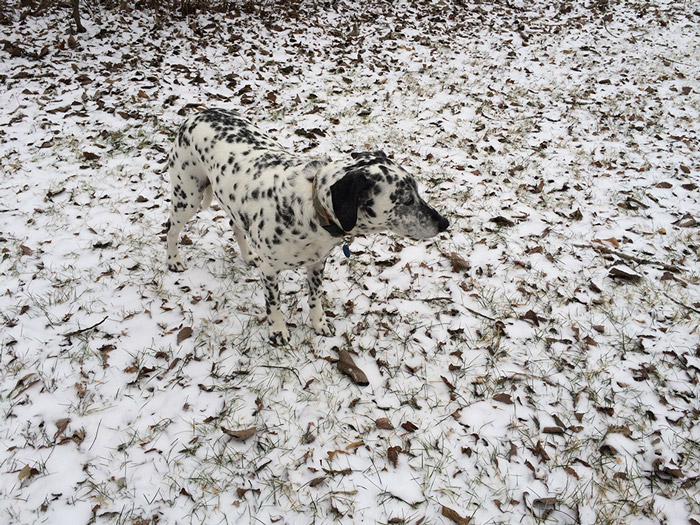
animal
dog
winter
room
still life
wall
iphone
pet
table
spots
hooks
(Image credit: Sophiya Strindlund)
Jun 21, 2014
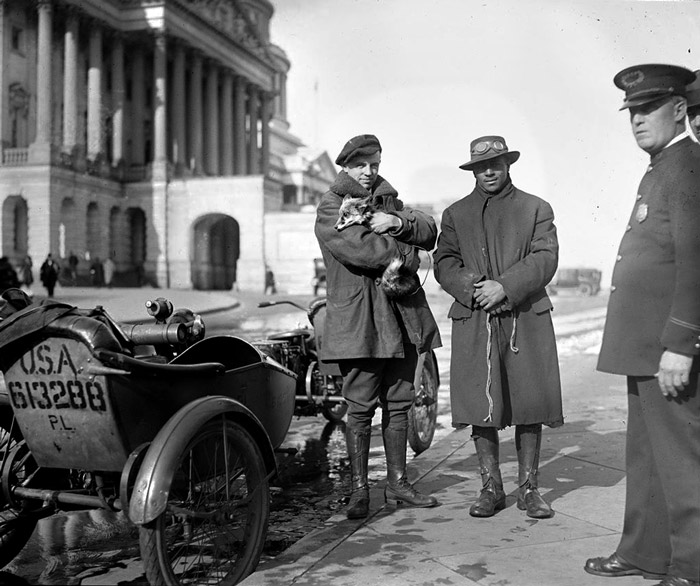 Men standing around in front of the U.S. Capitol building, holding a fox, 1919.
Men standing around in front of the U.S. Capitol building, holding a fox, 1919.
This photo comes from the files of the Office of the Architect, U.S. Capitol. The backstory is not known to us, but apparently foxes are observed from time to time roaming the grounds of the Capitol, feasting on squirrels. Just last February, tourists noted exactly that, and the Washington press corps twittered all about it.
animal
Washington
fox
1919
Capitol
(Image Credit: U.S. Capitol Office of the Architect)
Jan 27, 2016
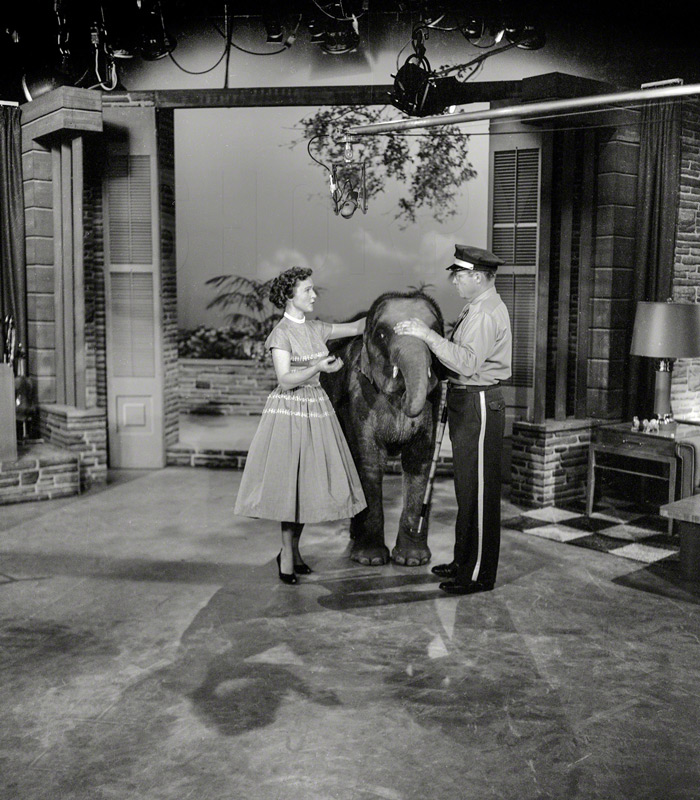 Last week, Betty White turned 94. She's probably been an animal person for at least 90 of those years. And of course she's been a Golden Girl for a really long time, and the Happy Homemaker for a long time before that. In fact, by our calculations, she's been in show business for at least 77 years.
Last week, Betty White turned 94. She's probably been an animal person for at least 90 of those years. And of course she's been a Golden Girl for a really long time, and the Happy Homemaker for a long time before that. In fact, by our calculations, she's been in show business for at least 77 years.
She first worked in front of a TV camera in 1939, when she was three months out of high school and the medium was still experimental. After volunteer service in World War II and a few postwar years working in radio, she came back to TV, and by 1952–when she was only 30 years old and still living at home with her parents–she was producing, directing, hosting, and singing and dancing in her own show.
This picture was taken on the set of the Betty White Show, in 1954. It was a noon-hour talk show; Betty chatted with guests, traded one-liners with the boys in the orchestra, sat at a desk to read jokes and riddles sent in by viewers, and swallowed a slug of Geritol to prove it tasted good and gave her lots of energy.
YouTube has preserved at least a couple of the show's episodes, from November 29th, 1954, when Rin Tin Tin makes a brief appearance near the end, and December 6th. Sadly, neither of those videos is any help in figuring out why Betty's got her hand on a baby elephant.
animal
1954
tv
Betty White
commercials
elephant
(Image via Shorpy.com)
Apr 3, 2016
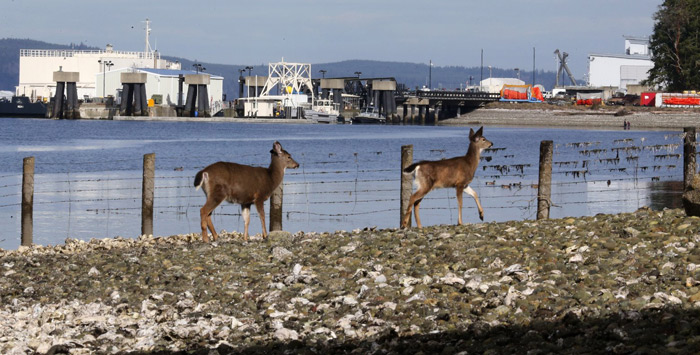 This fence is part of the security for Naval Base Kitsap–Bangor, home to eight submarines armed with Trident nuclear missiles.
This fence is part of the security for Naval Base Kitsap–Bangor, home to eight submarines armed with Trident nuclear missiles.
The deer are apparently not a security issue, but drones, on the other hand, are becoming a big problem. Multiple drone flights over the base been reported, all taking place at night, and nobody knows who is flying the drones or why.
Naval investigators have yet to solve the mystery. Nearby residents have been interviewed, but their involvement is doubtful. "I really can't imagine any of the neighbors or neighbors' kids thinking it's OK to run drones over Bangor," said one area resident who'd been interrogated about the incidents. "Everyone here is very aware that this is one of the most lethal places on earth."
Signs around the base perimeter warn "Keep Out. Use of force authorized."
animal
Washington
Navy
deer
wildlife
submarines
Bainbridge Island
Bangor
(Image credit: Ken Lambert for Seattle Times)




















 Believe it or not, there are in this world orangutans who just don't know what orangutans need to know. There are also orangutans who know full well how to be orangutans but who because of injury or illness can't get with the program. There are also orangutans who know how to be orangutans and are able and willing to live the orangutan life but who've lost their habitat.
Believe it or not, there are in this world orangutans who just don't know what orangutans need to know. There are also orangutans who know full well how to be orangutans but who because of injury or illness can't get with the program. There are also orangutans who know how to be orangutans and are able and willing to live the orangutan life but who've lost their habitat.
 Baby Goat, by Avram Dumitrescu, our very own Romanian Irish Texan painter. Click through for
Baby Goat, by Avram Dumitrescu, our very own Romanian Irish Texan painter. Click through for 






 This is not, of course, a New Zealand sheep; it's a Dutch sheep, trimmed to look not so much like a sheep, at the behest of Amsterdam artists Lernert & Sander, who'd been hired by a newspaper to illustrate a series on the theme of family.
This is not, of course, a New Zealand sheep; it's a Dutch sheep, trimmed to look not so much like a sheep, at the behest of Amsterdam artists Lernert & Sander, who'd been hired by a newspaper to illustrate a series on the theme of family.





